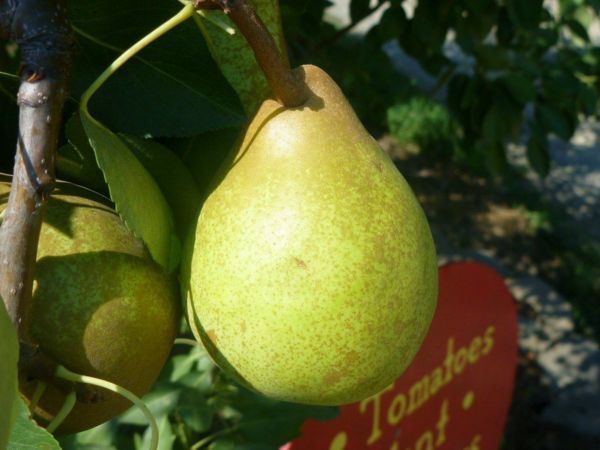An attractive, highly disease-resistant apple, ideal for organic growers.
Bartlett Pear on OHxF 87 (Spring 2024)
The most popular and common pear, and the yardstick by which all other pears are measured. Also known as Williams Pear, Williams' bon Chrétien.
Bartlett trees are very vigorous, precocious, and easily managed. They are tolerant of varied growing conditions, and they are an excellent choice for a grower who wants an easy, fast pear. Bartlett is partially self-fertile, but it will produce a better crop in the presence of a pollenizer. The only difficulty in Bartlett cultivation is its susceptibility to fireblight, scab, and pseudomonas. It is also particularly attractive to pear psylla. Bartlett is not compatible with quince rootstock and it should not be used as a pollination partner with Seckel.
This hierloom pear was discovered as a wildling by English schoolmaster John Stair, who cultivated it in Berkshire, England. By 1799 it had reached America, where it was grown in Roxbury, Massechussetts under the name Williams' bon Crétien, but in 1817 Enoch Bartlett of Dorchester, MA acquired the Brewer estate and produced the pear under his own name, "Bartlett." In England and France, however, the pear is still known as the Williams Pear. Under any name, this has become the most popular pear in Europe and America, and it accounts for about 50% of all US pear production today.
The fruit of the Bartlett is classically pyriform (pear shaped), wide at the base with a narrow neck, with a finely speckled thin green skin that ripens fully to a clear yellow. The flesh is fine grained and very juicy, and the flavor is sweet and aromatic. The fruit is harvested around August 20th in upstate NY, and it should be harvested when still green (ideally pressure tested for ripeness) and allowed to finish ripening to yellow off the tree. Bartlett stores well, will hold its form when baked, and is an excellent fresh eating pear.
The Fruit
Fruit Type
Category: Pear
Subcategory:
European, Self-Fertile, Cold-Hardy
Fruit Uses & Storage
Uses: fresh eating, baking, storage, canning
Storage duration: three plus months (approximate, depending on storage conditions)
Fruit Appearance
Skin color: yellow
Flesh color: off-white
Fruit Origins
Parentage: unknown
Origin: Berkshire, England
Introduced in: 1760s
Introduced by: John Stair
The Environment
Calendar & Geography
USDA zones: 4 - 8
Chill hours: 800
Ripening date: Aug 20 (approximate, in New York State) + 0 days after Bartlett
Tree Height & Spacing
glossary
Rootstock: OHxF 87 Rootstock
Rootstock size class: Half-Standard (75% of Standard)
Tree spacing: See details
Good for wildlife planting? N
Diseases & Pests
glossary
Fireblight: Very Susceptible
Pear Scab: Susceptible
Pseudomonas : Susceptible
Pear Psylla: Very Susceptible
Pollination
Pollination Factors
glossary
Bloom group: 3
Is it self-fertile? Partial
Is it fertile? Y
Ploidy: Diploid
Rootstock size class:
Half-Standard (75% of Standard)
Pollination Partners
This table shows the first few results from a full search for pollenizers of Bartlett Pear on OHxF 87. Please see our Pollenizer Search to run other queries and read how the application uses various factors. Also read more about fruit tree pollination.
See all pollination matches for Bartlett Pear on OHxF 87
Featured Products
A few things we're loving right now...
A full-flavored, freestone white peach.
One of America's oldest apples, good for storage, baking, and cider.
A widely-grown, large, yellow-fleshed nectarine.































